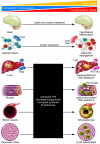Inflammatory links between obesity and metabolic disease
- PMID: 21633179
- PMCID: PMC3104776
- DOI: 10.1172/JCI57132
Inflammatory links between obesity and metabolic disease
Abstract
The obesity epidemic has forced us to evaluate the role of inflammation in the health complications of obesity. This has led to a convergence of the fields of immunology and nutrient physiology and the understanding that they are inextricably linked. The reframing of obesity as an inflammatory condition has had a wide impact on our conceptualization of obesity-associated diseases. In this Review, we highlight the cellular and molecular mechanisms at play in the generation of obesity-induced inflammation. We also emphasize how defining the immune regulation in metabolic tissues has broadened the understanding of the diversity of inflammatory responses.
Figures


References
Publication types
MeSH terms
Substances
Grants and funding
LinkOut - more resources
Full Text Sources
Other Literature Sources
Medical

